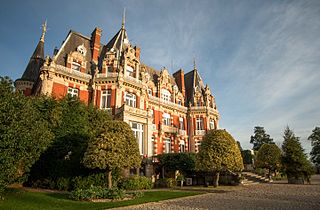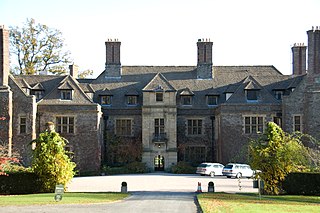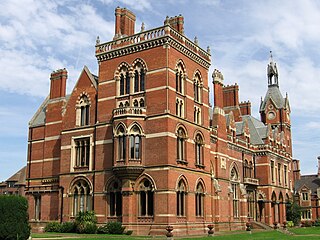
Thomas Seckford or Thomas Sakford Esquire was a senior lawyer, a "man of business" at the court of Queen Elizabeth I, a landowner of the armigerous Suffolk gentry, Member of Parliament, and public benefactor of the town of Woodbridge. He was one of the Masters in Ordinary of the Court of Requests to Queen Elizabeth, 1569-1587, and was Surveyor of the Court of Wards and Liveries 1581-1587. He built mansions in Woodbridge, Ipswich and Clerkenwell, and was at different times Steward of the Liberty of Ely in Suffolk, Bailiff for the Crown of the former possessions of Clerkenwell Priory in the City of London and County of Middlesex, and deputy Steward for the northern parts of the Duchy of Lancaster. He was the patron of Christopher Saxton in the making of the first surveyed County Atlas of England and Wales.

Lumley Castle is a 14th-century quadrangular castle at Chester-le-Street in the North of England, near the city of Durham and a property of the Earl of Scarbrough. It is a Grade I listed building. It is currently a hotel.
The Lord Leycester Hotel, often known simply as the Lord Leycester, is a former hotel in Warwick, England, that is located on Jury Street in the centre of the town. The building has variously been private housing, a hotel, and an inn during its history. Both the main building and the annexe are Grade II-listed buildings.

Chateau Impney Hotel & Exhibition Centre is a Grade II* listed 19th-century house built in the style of an elaborate French château near Droitwich Spa in Worcestershire, England. Of the large mansions in Worcestershire supported by industrial fortunes, Sir Nicolas Pevsner judged Impney to be "the showiest of them all in the county". Once a family home for local industrialist John Corbett, Chateau Impney has been a hotel since 1925.

Llangoed Hall is a country house hotel, near the village of Llyswen, in Powys, Mid Wales. It is known for its decoration in Laura Ashley fabrics and styles, and was owned by Sir Bernard Ashley, the widower of the designer. It is a Grade II* listed building, and its gardens and park are listed at Grade II on the Cadw/ICOMOS Register of Parks and Gardens of Special Historic Interest in Wales.

Dumbleton is a village and civil parish in the Tewkesbury district, in the county of Gloucestershire, England. The village is roughly 20 miles from the city of Gloucester. The village is known to have existed in the time of Æthelred I who granted land to Abingdon Abbey, and it is mentioned in the Domesday Book.

Woodbridge Tide Mill in Woodbridge, Suffolk, England is a rare example of a tide mill whose water wheel still turns and is capable of grinding a wholemeal flour.

Shrubland Hall, Coddenham, Suffolk, is a historic English country house with planned gardens in Suffolk, England, built in the 1770s.

Kelham is a small village and civil parish in Nottinghamshire about 3 miles (4.8 km) northwest of Newark on a bend in the A617 road near its crossing of the River Trent. The population of the civil parish taken at the 2011 census was 207.
The Blois family have been substantial landowners in Suffolk for several centuries. Until recently the family home was at Cockfield Hall in Yoxford, Suffolk, a Grade 1 listed private house standing in 40 acres (160,000 m2) of historic parkland.

Letton Hall is a Grade II listed eighteenth-century Neoclassical stately home designed by Sir John Soane for the Gurdon family between 1783 and 1789. It is located at Letton near Shipdham, Norfolk.

Norbury Manor is a 15th-century Elizabethan manor house and the adjoining 13th-century stone-built medieval hall house, Norbury Hall, known as The Old Manor in Norbury near Ashbourne, Derbyshire. It is a Grade I listed building.

Great Bealings is a small village in Suffolk, England. It has about 302 people living in it in around 113 households. Its nearest towns are Ipswich and Woodbridge. Nearby villages include Little Bealings, Playford, Culpho, Hasketon and Grundisburgh. The village does not have an obvious centre, and the population is split between two areas — one around Lower Street to the East of the village, and the other at Boot Street/Grundisburgh Road to the West of the village. St Mary's, the village church, is about in the middle of these two centres of population.

Brownsover Hall is a 19th-century mansion house in the old village of Brownsover, Rugby, Warwickshire which has been converted for use as a hotel. It is a Grade II* listed building.

Donington Hall is a mansion house set in parkland near Castle Donington village, North West Leicestershire. The Hall and Estate was purchased in April 2021 by MotorSport Vision, which also operates the neighbouring Donington Park racing circuit.

Grafton Manor was established before the Norman Conquest. Grafton means "settlement at or near the wood" and may indicate a role in woodland management within a larger estate, for instance.

Seckford Hospital is a grade II* listed former almshouse in Seckford Street, Woodbridge, Suffolk, England. It is of red brick with yellow brick dressings and was built by James Noble in 1840 to a design by Charles Cockerell. Despite its name, Seckford Hospital was never a hospital in the modern sense. Almshouses, providing charitable housing to the poor, were also known as bedehouses, poorhouses or hospitals. Today, as part of Seckford Care, Seckford Hospital provides care and support to older people and continues to be operated by The Seckford Trust founded by Thomas Seckford in the late 16th Century.

Hitchin Priory in Hitchin in Hertfordshire is today a hotel built in about 1700 on the site of a Carmelite friary founded in 1317, which was closed in the Dissolution of the Monasteries during the reign of Henry VIII. Parts of the original priory are incorporated in the existing building, which has been a Grade I listed building on the Register of Historic England since 1951.

The Shire Hall is a municipal building in Market Hill in Woodbridge, Suffolk, England. The structure, which is the meeting place of Woodbridge Town Council, is a Grade I listed building.

















